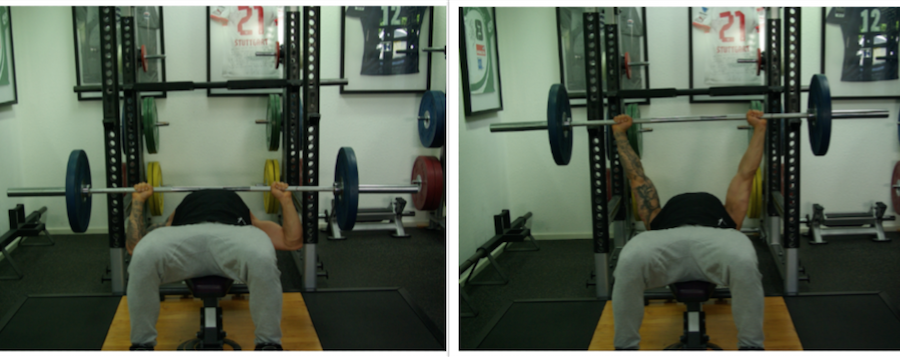Increasing the performance in the barbell flat bench press is the wish of many trainees in the gym. After a certain time, however, you often come across a plateau that does not allow further increases in the bench press. Assuming a correctly performed exercise over the entire range of motion, i.e. the barbell touches the chest at the turning point and the elbows are fully extended at the top point, statistically it is due to one or more of the following three factors that your performance in the bench press stagnates.
Statistically, the three most common limiting factors:
1. Control of eccentric movement. The eccentric part of the movement, i.e. lowering the barbell onto your chest when bench pressing, is much more decisive for muscle building and also for increasing strength than the concentric part. The speed and thus the duration of a repetition, which is measured in the so-called Time Under Tension (TUT), also plays an important role in the training effect. Whether you do 8 reps at a 2010 tempo in 24 seconds or 8 reps at a 5010 tempo in 48 seconds will result in less or more damage to the muscles and therefore less or more hypertrophy. For 24 Second TUT, a lower rep range and heavier weight would be more appropriate to generate the optimal training effect for strength gains, which are the primary goal of 24 Second TUT.
2. Control at the reversal point. Bouncing = letting the bar bounce off your chest – can be avoided in 99.9% of cases for various reasons. Weight control is important to prevent injury and overcome the sticking point in this area, as well as to recruit more pectoris major fibers. The tipping point is often the point where the weight can no longer be lifted off the chest without bouncing or outside help. The reason for this is too little control in this area and too little recruitment of the pectoralis.
3. Sticking point in the upper third (lockout). Straightening the arms at the end of the concentric phase is also a common problem for many lifters. Here the triceps is usually the limiting muscle.
An excellent advanced method to eliminate the three limiting factors mentioned is the double rest. It is a 4212 Tempo on paper. However, the pauses (the 2 seconds in the second and fourth digits of the tempo indication) are not made at the turning points as usual, but in the middle of the eccentric and concentric phase at an elbow angle of 90°.
This is how it looks in practice: lower the weight for 2 seconds to the middle of the eccentric movement, then pause for 2 seconds. Then lower completely for 2 seconds and quickly (without bouncing) move up to the middle of the concentric movement, pause there again for 2 seconds, then push the dumbbell up completely.
The advantage of this method is the isometric contraction at 90° elbow angles in the middle of the eccentric and concentric contraction which leads to more control of both phases of the repetition and also leads to more control at the two turning points, bottom of the chest and top of the final extension.
For an optimal training effect, 5 to 8 sets of 2 to 4 repetitions should be performed.
Example workout:
A1 LH Flat Bench Press, 6 sets of 3 reps, 4222 tempo, 120 sec rest
A2 pull-up, neutral, close grip, 6 sets of 3 reps, 5010 tempo, 120 sec rest
B1 Seated row, with rope, to the neck, pronated, 4 sets of 6 to 8 reps, 3011 tempo, 100 sec rest
B2 LH Seated Back Press, 4 sets of 4 to 6 reps, 4010 tempo, 100 sec rest
In order to become stronger - both globally and in a specific exercise - the weakest link in the chain must be made stronger. By training the three weak points described with the double break, you can overcome plateaus and take your bench press performance to the next level.
Good luck with the double break on the bench press!
Image: WBFF Pro Daniel Harder doing LH flat bench press with a medium grip during shoot for upcoming YPSI Handbook "Improve Your Arms"

